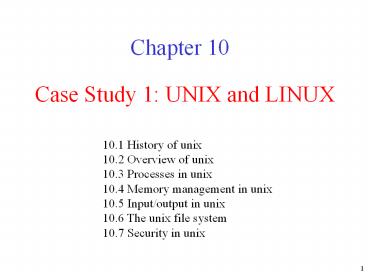Case Study 1: UNIX and LINUX PowerPoint PPT Presentation
Title: Case Study 1: UNIX and LINUX
1
Case Study 1 UNIX and LINUX
Chapter 10
10.1 History of unix 10.2 Overview of unix 10.3
Processes in unix 10.4 Memory management in unix
10.5 Input/output in unix 10.6 The unix file
system 10.7 Security in unix
2
UNIX
UserInterface
- The layers of a UNIX system.
3
UNIX Utility Programs
- A few of the more common UNIX utility programs
required by POSIX
4
UNIX Kernel
- Approximate structure of generic UNIX kernel
5
Processes in UNIX
- Process creation in UNIX.
6
POSIX
- The signals required by POSIX.
7
System Calls for Process Management
- s is an error code
- pid is a process ID
- residual is the remaining time from the previous
alarm
8
POSIX Shell
- A highly simplified shell
9
Threads in POSIX
- The principal POSIX thread calls.
10
The ls Command
- Steps in executing the command ls type to the
shell
11
Flags for Linux clone
- Bits in the sharing_flags bitmap
12
UNIX Scheduler
- The UNIX scheduler is based on a multilevel queue
structure
13
Booting UNIX
cp
- The sequences of processes used to boot some
systems
14
Handling Memory
Process A
Process B
- Process A's virtual address space
- Physical memory
- Process B's virtual address space
15
Sharing Files
- Two processes can share a mapped file.
A new file mapped simultaneously into two
processes
16
System Calls for Memory Management
- s is an error code
- b and addr are memory addresses
- len is a length
- prot controls protection
- flags are miscellaneous bits
- fd is a file descriptor
- offset is a file offset
17
Paging in UNIX
- The core map in 4BSD.
The core map has an entry for each page
18
Paging in Linux (1)
- Linux uses three-level page tables
19
Paging in Linux (2)
- Operation of the buddy algorithm.
Buddy algorithm
20
Networking
- Use of sockets for networking
21
Terminal Management
- The main POSIX calls for managing the terminal
22
UNIX I/O (1)
- Some of the fields of a typical cdevsw table
23
UNIX I/O (2)
- The UNIX I/O system in BSD
24
Streams
- An example of streams in System V
25
The UNIX File System (1)
- Some important directories found in most UNIX
systems
26
The UNIX File System (2)
- Before linking.
- After linking.
(a) Before linking. (b) After linking
27
The UNIX File System (3)
- Separate file systems
- After mounting
(a)
(b)
(a) Before mounting. (b) After mounting
28
Locking Files
- (a) File with one lock
- (b) Addition of a second lock
- (c) A third lock
29
System Calls for File Management
- s is an error code
- fd is a file descriptor
- position is a file offset
30
The lstat System Call
- Fields returned by the lstat system call.
31
System Calls for Directory Management
- s is an error code
- dir identifies a directory stream
- dirent is a directory entry
32
UNIX File System (1)
- Disk layout in classical UNIX systems
33
UNIX File System (2)
- Directory entry fields.
Structure of the i-node
34
UNIX File System (3)
- The relation between the file descriptor
table, the open file description
35
UNIX File System (4)
- A BSD directory with three files
- The same directory after the file voluminous has
been removed
36
The Linux File System
- Layout of the Linux Ex2 file system.
37
Network File System (1)
- Examples of remote mounted file systems
- Directories are shown as squares, files as circles
38
Network File System (2)
- The NFS layer structure.
The NFS layer structure
39
Security in UNIX
- Some examples of file protection modes
40
System Calls for File Protection
- s is an error code
- uid and gid are the UID and GID, respectively

